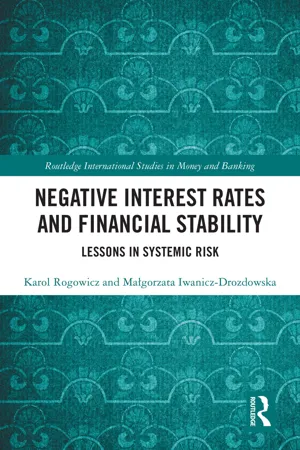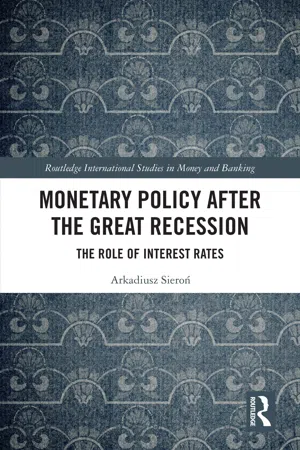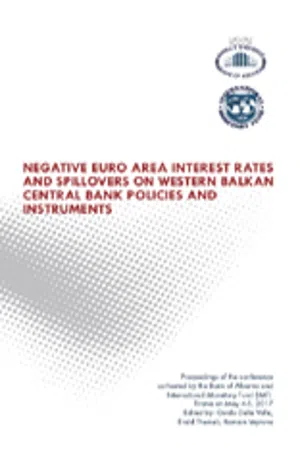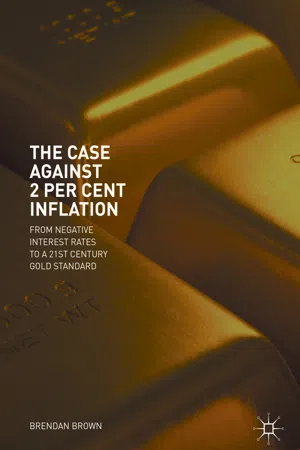Economics
Negative Interest Rate
Negative interest rates occur when central banks charge commercial banks for holding their excess reserves. This unconventional monetary policy is used to stimulate economic activity by encouraging banks to lend money rather than hoarding it. Negative interest rates can also impact savers and investors by reducing the returns on their deposits and investments.
Written by Perlego with AI-assistance
Related key terms
Related key terms
1 of 4
Related key terms
1 of 3
4 Key excerpts on "Negative Interest Rate"
- eBook - ePub
Negative Interest Rates and Financial Stability
Lessons in Systemic Risk
- Karol Rogowicz, Małgorzata Iwanicz-Drozdowska(Authors)
- 2022(Publication Date)
- Routledge(Publisher)
2 Negative Interest Rate Policy – A Theoretical Outline
DOI: 10.4324/9781003312116-22.1 The Concept of Interest Rate in Economics and Finance
In market economy, interest rate is among the key parameters underlying economic decision-making process. The economic literature provides several interest rate definitions, including the structure of its functions and its typology. Typically, interest rate in the economy is construed as a particular type of price/money cost (i.e., intertemporal price), much as definition approaches vary depending on the school of economic thought. Notwithstanding the tentative interest rate definition, the literature points out to its four major functions (e.g., Masiukiewicz, 1994 ): (i) allocation, which involves affecting aggregate investment and production structure in the economy; (ii) regulation, which comes down to maintaining balance on the capital and money markets whereby the interest rate is a tool for balancing supply and demand of loan capital; (iii) calculation, which enables examining the profitability of business entities’ investment decisions; and (iv) yield, which involves calculating income on capital investment. Analysis of the above functions is crucial as introducing a Negative Interest Rate policy may induce a disruption of this fundamental mechanism.2.1.1 Interest Rate Theories
According to the classical school of economics, the interest rate – although the classical economics alone did not relatively elaborate much on its very concept – may be viewed as a part of profit (e.g., according to A. Smith) or as premium paid for holding goods now versus the possibility to use them in the future (e.g., according to I. Fisher, 1930 ). It should also be emphasized that the classical theory assumes neutrality of money in the long term and it ignores the effect it has on setting the interest rate. It means that the existence of money is not a prerequisite for the interest rate to exist. From this perspective, classicists and neo-classicists (including I. Fisher) viewed the interest rate as a non-monetary category. At the same time, in their considerations, they denied it could be used as an active monetary policy instrument (Bilski, 2012 ). It is because, following Fisher’s theory, interest rate was market-developed by equating savings (supply of liquid capital, positively dependent on interest rate level) with investments (demand for liquid capital, reversely dependent on interest rate level). It is only K. Wicksell’s elaboration on this approach that showed the interest rate is determined by both real and monetary factors (Brózda-Wilamek, 2018 ). It was the first time in the history of economic thought that the role of monetary policy could be deemed as giving rise to interest rate fluctuations around the rate’s natural level. Moreover, K. Wicksell expanded the classical interest rate theory to include two additional interest rate types – a monetary rate (as a money cost charged by commercial banks on loans originated, set by supply and demand on the money market; Wicksell, 1934 - eBook - ePub
Monetary Policy after the Great Recession
The Role of Interest Rates
- Arkadiusz Sieroń(Author)
- 2020(Publication Date)
- Routledge(Publisher)
4The ECB joined the club on June 11, 2014, when the ECB reduced the rate it pays on overnight deposits with the central bank in excess of the reserve requirement to −0.10 percent. The ECB made further rate cuts in its deposit facility rate to −0.20 percent on September 10, 2014, to −0.30 percent on December 9, 2015, to −0.40 percent on March 16, 2016, and finally to −0.50 on September 18, 2019, as one can see in the Figure 6.1 below.Figure 6.1 ECB’s deposit facility rate from January 1999 to September 2019.Source: European Central Bank (2019), sdw.ecb.europa.eu , retrieved September 19, 2019.The ECB was followed by the Swiss National Bank (SNB) in 2014–15 and Norges Bank (NB) in 2015. In 2016, the Bank of Japan (BoJ), the National Bank of Hungary (NBH), the Bulgarian National Bank, and the Central Bank of Bosnia and Herzegovina also introduced a Negative Interest Rate policy (NIRP).5While all these central banks introduced some negative policy rates, the design and operational details of NIRP varied significantly across economies. Although all the above central banks started to charge a Negative Interest Rate on reserves deposited at them, only some of them also lowered the target for the key policy rate below zero. For example, NB and the NBH cut their deposit rates below zero but maintained positive interbank rates.6Moreover, several economies have tiered reserve systems, in which only a share of the reserves is subject to the negative marginal rate. Other central banks maintain exemption thresholds, which means that only reserves above these thresholds face the negative marginal rate. Such measures imply that the average rate and the marginal rate differ. Thus, economies with the most negative marginal rates may not be those with the most negative average rates (Bech and Malkhozov 2016; Angrick and Nemoto 2017). - eBook - ePub
- International Monetary Fund(Author)
- 2017(Publication Date)
- INTERNATIONAL MONETARY FUND(Publisher)
In fact, I headed the working group preparing the concept of Negative Interest Rates, and one of the first arguments I had was whether there was such a thing as “Negative Interest Rate” and whether we could thus use that term. I think some people remained unconvinced until the ECB finally introduced Negative Interest Rates and used that term. But beyond terminology, there was the more serious assertion that Negative Interest Rates were not merely a continuation of values on a scale that goes below zero. Rather, it was argued that lowering interest rates below zero was like cooling water below zero degrees Celsius: the physical properties would change, water would freeze, and you would suddenly be in a very different physical environment. But as Ulrich already noted: we learned that this is not the case. Negative Interest Rates are a continuation of values on a scale that goes below zero, at least within the range of Negative Interest Rates that we have experienced so far. Nothing unexpected happened; markets and the transmission mechanism continue to work. The first central bank to actually introduce binding Negative Interest Rates was the Danish National Bank. They did it in 2012, and it provided a welcome case study for us. We were in close contact with the Danish National Bank during that time, and their experience confirmed that Negative Interest Rates could be used to counter appreciation pressure on the exchange rate. In Figure 3, you can see the policy rates of different central banks. As you can see, the Swiss National Bank lowered its policy rate quickly in the autumn of 2008, like the Fed and the ECB, and we reached zero in 2011. Given that in our case the policy rate is the three-month Swiss franc Libor, and not an overnight rate, the Swiss monetary policy stance is even somewhat more expansionary at a given policy rate relative to the Fed and the ECB - eBook - ePub
The Case Against 2 Per Cent Inflation
From Negative Interest Rates to a 21st Century Gold Standard
- Brendan Brown(Author)
- 2018(Publication Date)
- Palgrave Macmillan(Publisher)
But storage of these is not costless. And so, in practice rates can fall to slightly negative levels even under a conventional monetary regime. Moreover, banks may decide not to pass negative rates on to customers even if they are receiving less than zero on their reserves at the central bank, because the costs of regaining lost customers could be more than the absorption (by the bank) of the negative income on reserves. Wholesale money deposits by contrast and some large deposits would be subject to negative rates (as quoted by the banks). Under the global 2% inflation standard, central banks in Europe and Japan have experimented with modestly negative rates as described. In effect reserves at the central bank become subject to a charge (sometimes this is levied just on marginal excess reserves rather than on total reserves, meaning more scope for banks to avoid passing negative rates on to clients). Are Slightly Negative Rates Worth the Candle? The question in all this is whether the game is really worth the candle. After all, in a well-functioning capitalist economy under sound money where prices and wages are flexible both downwards and upwards, the zero-rate boundary does not prevent real interest rates falling to negative levels in real terms (see Chap. 2, p. 21). Expectations of higher prices in the future from a below-normal level now are the mechanism for sub-zero generation. In particular goods and services for which demand is now cyclically weak would fall to a below-normal level from which price recovery would be expected over the subsequent recovery. Businesses and consumers would bring forward their purchases
Index pages curate the most relevant extracts from our library of academic textbooks. They’ve been created using an in-house natural language model (NLM), each adding context and meaning to key research topics.
Explore more topic indexes
Explore more topic indexes
1 of 6
Explore more topic indexes
1 of 4



